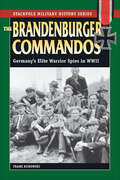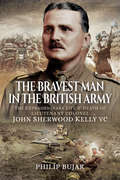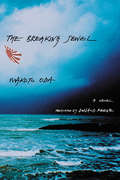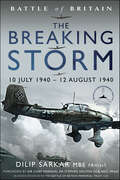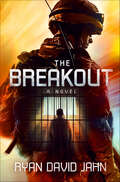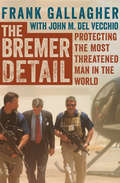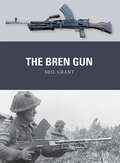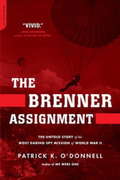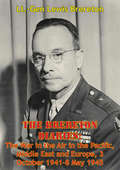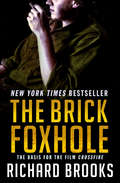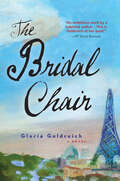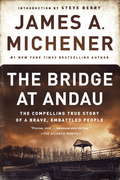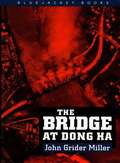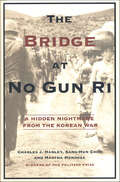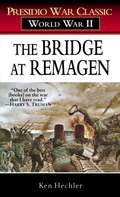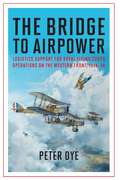- Table View
- List View
The Brandenburger Commandos: Germany's Elite Warrior Spies in World War II (Stackpole Military History Series)
by Franz KurowskiThis WWII history chronicles the exploits of an elite German spy unit and offers a rare look into the secret operations of Hitler's military. Directed by the German Army&’s intelligence service, the Brandenburgers became legendary for their brutally efficient clandestine operations. Trained to be quick, mobile, and self-reliant and steeped in local customs and languages, they operated behind enemy lines around the world. Across the battlefronts of the Second World War—from Western Europe to Romania, Russia, Egypt, Afghanistan, and beyond—they seized bridges and other strategic targets; engaged in sabotage, espionage, and other daring missions; and often disregarding the rules of war in the process. Although the unit was dissolved in 1944, its tactics influenced special forces around the world both during the war and after.
The Brave Captains
by V. A. StuartOctober 1854: Admidst brutal cannonade and flashing sabers, the Plain of Balaclava thundered to two of the most incredible military maneuvers of all time—the charge of the Heavy and Light Brigades. As the Russian cavalry prepares to launch a full-scale attack to seize Balaclava, the British find themselves in desperate straits. Dangerously outnumbered, they are hoping for reinforcements, but in the meantime they must hold their ground, calling for heroism that will test the courage of even the bravest man. Dodging bursting shells and Russian Cossacks, Hazard proves that the bluejackets fight as well on land as they do at sea.
The Brave Free Men
by Jack VanceThe Faceless Man is a prisoner in his own palace. His power over the people of Durdane is in the hands of Gastel Etzwane, a youth whose thirst for vengeance against the dreaded Rogushkoi would be slaked only by oceans of their blood. For these invincible foes who threatened Durdane had taken and killed his mother and sister. To destroy the Rogushkoi Gastel would have to unite a world that survived only through its separateness. It was more than dangerous, but he had no choice. If they were to fight the people must regain control of their own lives. Only then could Gastel recruit an elite corps of the liberated - the Brave Free Men - to fling against the Rogushkoi and fight to the death.
The Bravest Man
by William Tuohy"There's no margin for mistakes in submarines. You're either alive or dead."-Richard O'KaneHailed as the ace of aces, captain Richard O'Kane, winner of the Congressional Medal of Honor for his consummate skill and heroism as a submarine skipper, sank more enemy ships and saved more downed fliers than anyone else.Now Pulitzer Prize--winning author William Tuohy captures all the danger, the terror, and the pulse-pounding action of undersea combat as he chronicles O'Kane's wartime career-from his valiant service as executive officer under Wahoo skipper Dudley "Mush" Morton to his electrifying patrols as commander of the USS Tang and his incredible escape, with eight other survivors, after Tang was sunk by its own defective torpedo.Above all, The Bravest Man is the dramatic story of mavericks who broke the rules and set the pace to become a new breed of hunter/killer submariners who waged a unique brand of warfare. These undersea warriors would blaze their own path to victory-and transform the "Silent Service" into the deadliest fighting force in the Pacific.From the Paperback edition.
The Bravest Man
by William Tuohy"There's no margin for mistakes in submarines. You're either alive or dead."-Richard O'KaneHailed as the ace of aces, captain Richard O'Kane, winner of the Congressional Medal of Honor for his consummate skill and heroism as a submarine skipper, sank more enemy ships and saved more downed fliers than anyone else.Now Pulitzer Prize--winning author William Tuohy captures all the danger, the terror, and the pulse-pounding action of undersea combat as he chronicles O'Kane's wartime career-from his valiant service as executive officer under Wahoo skipper Dudley "Mush" Morton to his electrifying patrols as commander of the USS Tang and his incredible escape, with eight other survivors, after Tang was sunk by its own defective torpedo.Above all, The Bravest Man is the dramatic story of mavericks who broke the rules and set the pace to become a new breed of hunter/killer submariners who waged a unique brand of warfare. These undersea warriors would blaze their own path to victory-and transform the "Silent Service" into the deadliest fighting force in the Pacific.From the Paperback edition.
The Bravest Man in the British Army: The Extraordinary Life and Death of John Sherwood Kelly
by Philip BujakToday a new major joined us, a Herculean giant of South African origin with a quite remarkable disregard for danger.' _The Regimental Diary of The Kings Own Scottish Borderers, July 1915_'Brave as a lion, stubborn as a mule and as quick tempered as his Irish forebears, Kelly VC spoke out about Churchill's support of the White Russians in 1919. This is a well researched and lively read and brings to our attention an early Churchill folly.' _Keith Simpson_John (Jack) Sherwood Kelly, VC CMG DSO (1880-1931) was a formidable soldier. He fought in British colonial campaigns in the early 1900s, distinguished himself during the First World War at Gallipoli, the Somme and Cambrai, and, after the war, was involved in the British campaign in northern Russia in support of the White Russians. During his military career he achieved fame and notoriety for his mixture of heroic exploits and explosive temperament. In this meticulously researched and vivid biography Jake B. Liphuip tells Sherwood Kellys story and gives a fascinating insight into one of the most remarkable and controversial military men of the period. Kelly had a combat record going back to the 1896 Matabele Revolt. He was awarded the DSO for his exploits in Gallipoli in 1916. During 1917 he commanded 1st Battalion, the Royal Inniskilling Fusiliers and was instrumental in the early success achieved during the Battle of Cambrai for which he was awarded the VC. His later service during the British intervention against the Bolsheviks in 1919 ended in court martial and a highly publicized clash with Winston Churchill.
The Bravest Man: Richard O'Kane and the Amazing Submarine Adventures of the USS Tang
by William Tuohy"There's no margin for mistakes in submarines. You're either alive or dead. " -Richard O'Kane Hailed as the ace of aces, captain Richard O'Kane, winner of the Congressional Medal of Honor for his consummate skill and heroism as a submarine skipper, sank more enemy ships and saved more downed fliers than anyone else. Now Pulitzer Prize--winning author William Tuohy captures all the danger, the terror, and the pulse-pounding action of undersea combat as he chronicles O'Kane's wartime career-from his valiant service as executive officer under Wahoo skipper Dudley "Mush" Morton to his electrifying patrols as commander of the USS Tangand his incredible escape, with eight other survivors, after Tang was sunk by its own defective torpedo. Above all, The Bravest Manis the dramatic story of mavericks who broke the rules and set the pace to become a new breed of hunter/killer submariners who waged a unique brand of warfare. These undersea warriors would blaze their own path to victory-and transform the "Silent Service" into the deadliest fighting force in the Pacific. From the Paperback edition.
The Bravest of the Brave: The Correspondence of Stephen Dodson Ramseur
by Gary W. Gallagher George G. KundahlBorn in Lincolnton, North Carolina, in 1837, Stephen Dodson Ramseur rose meteorically through the military ranks. Graduating from West Point in 1860, he joined the Confederate army as a captain. By the time of his death near the end of the war at the Battle of Cedar Creek, he had attained the rank of major general in the Army of Northern Virginia. He excelled in every assignment and was involved as a senior officer in many of the war's most important conflicts east of the Appalachians. Ramseur's letters--over 180 of which are collected and transcribed here by George Kundahl--provide his incisive observations on these military events. At the same time, they offer rare insight into the personal opinions of a high-ranking Civil War officer. Correspondence by Civil War figures is often strictly professional. But in personal letters to his wife, Nellie, and best friend, David Schenk, Ramseur candidly expresses beliefs about the social, military, and political issues of the day. He also shares vivid accounts of battle and daily camp life, providing colorful details on soldiering during the war.
The Breaking Jewel: A Novel (Weatherhead Books on Asia)
by Makoto OdaSet on an island in the South Pacific during the final days of World War II, when the tide has turned against Japan and the war has unmistakably become one of attrition, The Breaking Jewel offers a rare depiction of the Pacific War from the Japanese side and captures the essence of Japan's doomed imperial aims. The novel opens as a small force of Japanese soldiers prepares to defend a tiny and ultimately insignificant island from a full-scale assault by American forces. Its story centers on squad leader Nakamura, who resists the Americans to the end, as he and his comrades grapple with the idea of gyokusai (translated as "the breaking jewel" or the "pulverization of the gem"), the patriotic act of mass suicide in defense of the homeland. Well known for his antiestablishment and antiwar sentiments, Makuto Oda gradually and subtly develops a powerful critique of the war and the racialist imperial aims that proved Japan's undoing.
The Breaking Storm: 10 July 1940 – 12 August 1940
by Dilip SarkarIn The Breaking Storm, the first of Dilip Sarkar’s unprecedented seven-volume series exploring the Battle of Britain, the events that led up to the outbreak of war in 1939, and which set the scene for the epic aerial conflict of summer 1940, are fully explored. Continuing his examination of the events of the Spitfire Summer, in The Breaking Storm Dilip provides a day-by-day chronicle of the Battle of Britain’s first phase – the so-called Kanalkampf – which was fought over the Channel-bound convoys between 10 July and 12 August 1940. This account, though, does not simply concern RAF Fighter Command, as the author recognizes the operations and efforts of the RAF’s Bomber and Coastal commands, the Royal Navy and mercantile marine – making this book part of what he calls ‘the Big story’. Hitler’s actual policies and intentions towards the ongoing war with Britain are also explored. If the Battle of Britain was fought to deny Germany the aerial superiority required to launch a seaborne invasion of southern England, then, the author argues, the conflict could surely only have begun when the Germans committed to Operation Seelöwe – which was not, in fact, until 21 July 1940. It has previously been accepted that Hitler’s War Directive of 16 July 1940 signaled the intention to invade, but the author proves that this was no more than another example of the ‘brinkmanship’ that Hitler was renowned for, and the air attacks at that time little more than ‘Air Fleet Diplomacy’, all of which was intended to frighten Britain into accepting the Führer’s ‘last appeal to reason’ of 19 July 1940. In his broadcast of 22 July 1940, Lord Halifax made the nation’s unbowed position quite clear. He called Hitler’s bluff: previously reluctant to fight Britain, Hitler’s preferred policy in the ongoing war had been blockade and diplomacy – but now he had no choice but to unleash the Luftwaffe against Britain. All of this is investigated in detail, aligning these wider events and high decisions with action in the air. Through diligent research, combined with crucial official primary sources and personal papers, Dilip unravels many myths, often challenging the accepted narrative. This is not simply another dull record of combat losses and claims – far from it. Drawing upon unique first-hand accounts from a wide-range of combatants and eyewitnesses, along with Daily Home Intelligence Reports and numerous other primary sources, this book forms part of what is likely to be the first and last such comprehensively woven account of this epic air battle.
The Breakout: A Novel
by Ryan David JahnIn this military thriller, a US Marine Corps sniper’s quest for vengeance traps him in a Mexican prison, and only his brothers in arms can rescue him.James Murphy is a Marine Corps sniper. He’s done two tours in Afghanistan. He’s considered an American Hero. And James is out for revenge.Alejandro Rocha, a massively powerful drug kingpin who operates out of La Paz, Mexico, is responsible for the death of James’s sister, and James intends to make Rocha pay for it.James goes AWOL from his unit and travels to Mexico, ready to enact bloody vengeance, but before he can go through with his plan, the crooked police of La Paz arrest him. He’s quickly thrown into a dangerous prison on trumped-up charges. He knows he is marked for death while in this prison, and there’s nothing he can do about it. However, there is a group of people who can do something about it . . .Discovering that James is wasting away in a Mexican prison, the Marines in his unit decide to risk court-martial themselves and go AWOL as well, ready to go to war to free their brother. And that’s just the beginning of the mayhem and violence . . .
The Breakup of Yugoslavia and the War in Bosnia
by Carole RogelA brief but careful history of the period.
The Bremer Detail: Protecting the Most Threatened Man in the World
by John M. Del Vecchio Frank GallagherBaghdad, 2003: An elite group of private security contractors is charged with protecting the American who rules Iraq In May 2003 President George W. Bush appointed Paul Bremer as presidential envoy to Iraq. Bremer banned the Ba'ath party and dismantled the Iraqi army, which made him the prime target for dozens of insurgent and terrorist groups. Assigned to protect him during his grueling sixteen-hour days were Blackwater security expert Frank Gallagher and a team of former Marines, SEALs, and other defense professionals. When they arrived, Baghdad was set to explode. As the insurgency gathered strength Bremer and the men who guarded him faced death daily. They were not in the military, but Gallagher and his team were on the front lines of the Iraq War. This fascinating memoir takes the reader deep behind the scenes of a highly dangerous profession.This ebook includes ten pages of action photos from the author's time in Baghdad.
The Bren Gun
by Peter Dennis Neil GrantIn World War II the Britsh Bren light machine gun saw service in Commonwealth armies and in resistance forces throughout Europe, Africa, and Asia. Adopted in 1938 and remaining in British service right up to 1991, the popular and reliable Bren was an iconic light machine gun, and probably the most recognisable Commonwealth weapon of World War II. Gas-operated and magazine-fed, it was based on a Czech design and was issued in large numbers during and after World War II as a section-level automatic weapon; it used the same .303in ammunition as the Lee-Enfield rifles that equipped British and Commonwealth infantry, and the Pattern 1937 webbing they wore was designed around the dimensions of the Bren's distinctively curved 28-round magazine.Offering remarkable accuracy for an LMG, the Bren had an effective range of 600yd, but could reach out to over 1,500yd. It was generally fired from the prone position using a bipod, but could be fired from the hip when necessary. If kept clean, the Bren gave reliable service in the harshest of environments, from the deserts of Libya to the Korean mountains in winter. As well as seeing widespread infantry use, the Bren was widely supplied to resistance movements in Occupied Europe. It was often vehicle-mounted, notably in the Universal Carrier, popularly called the 'Bren Carrier'; however, the Bren's design precluded its use as a coaxial weapon in tanks and other armoured fighting vehicles.When the UK adopted the 7.62mm NATO cartridge from 1958, the Bren was adapted for this new, rimless ammunition and redesignated the L4; this further improved the Bren's already solid reliability and made it possible for SLR magazines to be used in the weapon. Although officially superseded by the L7 GPMG, the Bren remained a popular weapon in the many post-1945 conflicts involving British and Commonwealth forces, owing to its light weight, manageable length and sheer dependability. Featuring specially commissioned full-colour artwork and based on meticulous research, this is the engaging story of the Bren, the iconic light machine gun that equipped British and Commonwealth forces throughout World War II and in a host of postwar conflicts right up to the Falklands and beyond.
The Brenner Assignment: The Untold Story of the Most Daring Spy Mission of World War II
by Patrick K. O'DonnellLike a scene from Where Eagles Dare, a small team of American spies parachutes into Italy behind enemy lines. <P><P>Their orders: link up with local partisans and sabotage the well-guarded Brenner Pass-the Nazis' crucial supply route through the Alps-thereby bringing the German war effort in Italy to a grinding halt.
The Brereton Diaries: The War In The Air In The Pacific, Middle East And Europe, 3 October 1941-8 May 1945
by Lieutenant-General Lewis H. BreretonLieutenant-General Brereton was a long service aviator in the United States Air Force even before the advent of the Second World War, Tough and aggressive he would lead his men and air groups through the Pacific, North Africa and Europe, and saw action in more theatres than any other senior commander. Described by one of his fellow US generals "a cocky, aggressive, intelligent, experienced, pretty damn able commander.", he is a somewhat controversial character. He was in command during four of the most controversial, from an Air Force perspective, episodes of the entire war; the initial destruction of the American aerial assets in the Philippines 1941, the bombing of the oilfields in Ploesti 1943, the flattening of the German defences in Normandy 1944, and the failed attempt to capture bridges across the Rhine by airdrop 1944.His diary is very readable, enlightening and very relevant to the US Air Force effort in all of the major theaters across World War II.
The Brick Foxhole
by Richard BrooksNew York Times Bestseller: This &“shocking&” murder mystery addresses homophobia in the military during World War II (Richard Wright, author of Native Son). The men in the barracks, wrenched from the normal pursuits of life, are being molded into warriors in a battle against the &“others.&” Isolated and fearful, they sometimes relieve their frustrations on the most disenfranchised civilians, namely homosexuals. But one weekend, one of them loses control and commits murder. This tale of suspense is also a story ahead of its time, written by a young marine stationed at Quantico who would go on to become an Academy Award–winning director of such films as Elmer Gantry and The Blackboard Jungle. Sinclair Lewis, writing in Esquire, called Richard Brooks &“a really important new writer&” and The Brick Foxhole was acclaimed in the Saturday Reviewof Literature as &“angry, rapid, stream-lined, and beautifully written . . . the best of the new stuff coming out of this war&”—though the US Marines threatened the author with court-martial. Eventually, the story was made into the movie Crossfire (with the hate crime in question changed to an act of anti-Semitic rather than antigay violence), which earned Brooks an Edgar Award for Best Motion Picture. Today, The Brick Foxhole remains both a twisting thriller and an early landmark of gay-themed fiction.
The Bridal Chair: A Novel
by Gloria Goldreich"In prose as painterly and evocative as Chagall's own dazzling brushstrokes, Gloria Goldreich finely evokes one of the most significant masters of modern art through the discerning eyes of [his] loyally protective daughter."—Cynthia Ozick, award-winning author of Foreign BodiesAn exquisite, haunting exploration of the complex mind of Marc Chagall, and the artist's famous chair, through the eyes of his daughter during World War II—perfect for fans of Mrs. Poe and The Paris WifeBeautiful Ida Chagall, the only daughter of Marc Chagall, is blossoming in the Paris art world beyond her father's controlling gaze. But, her newfound independence is cut short by the chaos of World War II. In Nazi-occupied Paris, her father's status as a Jewish artist has made them all targets, but his devotion to his art blinds him to their danger.When Ida falls in love and Chagall angrily paints an empty wedding chair in response, she faces an impossible choice: Does she fight to escape her father's shadow entirely, or abandon her ambitions to save Chagall from the peril in Paris, his enemies, and himself?Brimming with historic personalities from WWII Europe, America and Israel, The Bridal Chair is a stunning portrait of love, fortitude, and the sharp divide between art and real life."Only Gloria Goldreich could write a novel so grounded in historical truths yet so exuberantly imaginative. The Bridal Chair is Goldreich at her best, with a mesmerizing plot, elegant images, and a remarkable heroine who...will remain with you long after the last page."—Francine Klagsburn, Jewish Week columnist and acclaimed author of Voices of Wisdom"Filled with fascinating details about the art world and colorful real-life characters, this novel may appeal to historical fiction fans who enjoyed Natasha Solomons's The House at Tyneford and Tatiana de Rosnay's Sarah's Key."—Library Journal
The Bridge Builder's Story: A Novel
by Howard Fast1939. A honeymoon in Europe. A tragic encounter. A man and woman's desperate struggle for healing and love.
The Bridge at Andau: The Compelling True Story of a Brave, Embattled People
by James A. Michener Steve BerryThe Bridge at Andau is James A. Michener at his most gripping. His classic nonfiction account of a doomed uprising is as searing and unforgettable as any of his bestselling novels. For five brief, glorious days in the autumn of 1956, the Hungarian revolution gave its people a glimpse at a different kind of future--until, at four o'clock in the morning on a Sunday in November, the citizens of Budapest awoke to the shattering sound of Russian tanks ravaging their streets. The revolution was over. But freedom beckoned in the form of a small footbridge at Andau, on the Austrian border. By an accident of history it became, for a few harrowing weeks, one of the most important crossings in the world, as the soul of a nation fled across its unsteady planks. BONUS: This edition includes an excerpt from James A. Michener's Poland. Praise for The Bridge at Andau "Precise, vivid . . . immeasurably stirring."--The Atlantic Monthly "Dramatic, chilling, enraging."--San Francisco Chronicle "Superb."--Kirkus Reviews "Highly recommended reading."--Library Journal
The Bridge at Dong Ha
by John Grider MillerIn his desperate attempt to blow up the bridge at Dong Ha and keep some 30,000 men and 200 tanks at bay, Ripley endured three hours of direct fire to rig some 500 pounds of explosives. Such a story of raw courage and personal resolve is rarely encountered.
The Bridge at No Gun Ri: A Hidden Nightmare from the Korean War
by Charles J. Hanley Martha Mendoza Sang-hun ChoeThe untold human story of a massacre of Korean civilians by American soldiers in the early days of the Korean War, by the Pulitzer Prize-winning journalists who uncovered it.In the fall of 1999, a team of Associated Press investigative reporters broke the news that U.S. troops had massacred a large group of South Korean civilians early in the Korean War. On the eve of that pivotal war's 50th anniversary, their reports brought to light a story that had been suppressed for decades, confirming allegations the U.S. military had sought to dismiss. It made headlines around the world. In The Bridge at No Gun Ri, the team tells the larger, human story behind the incident through the eyes of the people who survived it: on the American side, the green recruits of the "good time" U.S. occupation army in Japan made up of teenagers who viewed unarmed farmers as enemies and generals who had never led men into battle; on the Korean side, the peasant families forced to flee their ancestral village caught between the invading North Koreans and the U.S. Army. The narrative looks at victims both Korean and American; at the ordinary lives and high-level decisions that led to the fatal encounter; at the terror of the three-day slaughter; at the memories and ghosts that forever haunted the survivors. The story of No Gun Ri also illuminates the larger story of the Korean War-also known as the Forgotten War-and how an arbitrary decision to divide the country in 1945 led to the first armed conflict of the Cold War.
The Bridge at Remagen: A Story of World War II (Presidio War Classic Ser.)
by Ken HechlerIt was a stunning strategic victory of World War II–and one of the most fantastic breaks for the Allies. On March 7, 1945, a small group of American infantrymen, engineers, and tank crews secured the Ludendorff Bridge that crossed the Rhine. The successful mission saved thousands of American lives and spearheaded the invasion of Nazi Germany. The Bridge at Remagen is the detailed narrative of this surprising but crucial military action, one that stunned the German army. It is also the moving story of men who did not consider themselves heroes, but who performed magnificently under fire. In this amazing true story, Ken Hechler gives you the hour-by-hour account of brilliant military daring, human courage, and almost incredible luck that profoundly changed the course of the war. From the Paperback edition.
The Bridge to Airpower
by Peter DyeThe Bridge to Air Power describes how the development of the air weapon on the Western Front during the First World War required a radical and unprecedented change in the way that national resources were employed to exploit a technological opportunity. By examining the performance of the Royal Flying Corps, and its successor the Royal Air Force - the world’s first independent air service - it explains how logistic competence was the precondition for air superiority and the 'modern style of warfare’ - in the form of indirect, predicted artillery fire. The Royal Flying Corps was led by a new breed of soldier-technocrats, who combined military values, managerial competence and business skills. The outcome was a new style of warfare that wove together industrial mobilization, national resources and operational art. The Royal Flying Corps’ logistic staffs, led by Brigadier-General Robert Brooke-Popham, demonstrated considerable agility in meeting the demands of three-dimensional warfare. Providing adequate numbers of frontline aircraft to maintain air operations in support of the British Expeditionary Force, required substantial numbers of skilled and semi-skilled personnel, located largely beyond the battle zone, operating at a continuously high tempo while coping with rapid technological change and high wastage. These elements formed a complex, dynamic and integrated network that was also partly self-sustaining, in the form of salvage and repair, with the ability to compensate for shortfalls in aircraft and aero-engine production as well as unpredicted demand. This was a time critical process that required careful planning to balance quantity, quality, resilience and efficiency for maximum military effect while coping with unpredictable weather, operational uncertainty and tactical innovation. The Royal Flying Corps’ logistic system was modern both in its needs and in the processes developed to meet these needs. A variety of logistic techniques were pioneered including, supply chain integration, strategic warehousing, velocity management, postponement and make-to-order, new product introduction, international sourcing, hybrid and reverse logistics. In creating the foundation for three-dimensional warfare, logistics became the bridge between the nation’s economy and air power. The principles developed on the Western Front to achieve air superiority provided the foundation for Royal Air Force logistic and operational success in the Second World War as well as anticipating the management practices that underpin today’s global supply chain.
The Bridgebusters: The True Story of the Catch-22 Bomb Wing
by Thomas Mckelvey Cleaver"He had decided to live forever, or die in the attempt." - Catch-22 <P><P>The men of the 57th Bomb Wing flew out of Corsica during World War II and bombed vital bridges throughout Italy to sabotage German supply routes. Their missions were dangerous and never-ending. <P><P>One bombardier in the wing was a young New Yorker named Joseph Heller, who would later turn his experience into the classic 1961 war novel Catch-22. <P><P>Now aviation historian Thomas McKelvey Cleaver takes a closer look at the real-life men of the 57th, whose camaraderie in the face of death inspired the raucous cast of heroes and antiheros in Catch-22.
